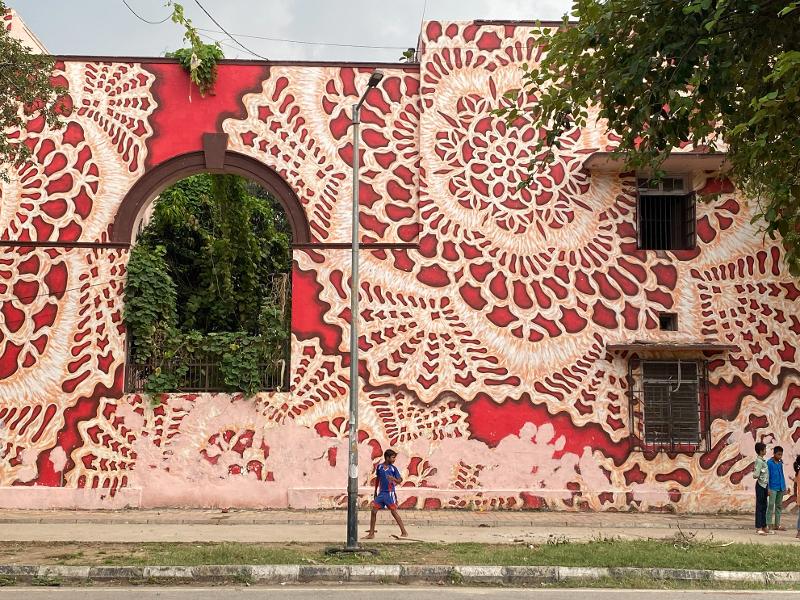Delhi's street art scene is a captivating blend of artistic expression and social commentary. From the elaborate painted public service messages to the collaborative murals created by street artists and government institutions, the city's walls have become a canvas for creativity. Join me on a journey through Delhi's vibrant street art scene, where talented artists showcase their talent and inspire change.
The Power of Street Art in Delhi
Explore how street art in Delhi serves as a powerful medium for social commentary and self-expression.
Street art in Delhi goes beyond mere aesthetics. It serves as a powerful medium for social commentary, giving a voice to the marginalized and addressing important issues. Artists use walls as their canvas to express their thoughts and emotions, creating thought-provoking murals that challenge societal norms and inspire change.
Through their vibrant and captivating artworks, street artists in Delhi spark conversations and raise awareness about topics such as public health, gender equality, and environmental sustainability. Their creations not only beautify the city but also serve as a catalyst for social transformation.
Collaborations Between Artists and Government Institutions
Discover the unique collaborations between street artists and government institutions in Delhi, resulting in stunning murals that redefine public spaces.
One of the unique aspects of Delhi's street art scene is the collaboration between artists and government institutions. These partnerships have led to the creation of breathtaking murals that redefine public spaces and challenge traditional notions of art.
For example, Tihar Jail, one of Delhi's largest prisons, joined forces with the Delhi-based not-for-profit organization St+art to create India's longest mural. Artists ran workshops for inmates, allowing them to express their creativity and contribute to the artwork. This collaboration not only transformed the prison walls but also provided a platform for inmates to share their stories and emotions.
Another notable collaboration took place at New Delhi's Police Headquarters, where German street artist Hendrick ECB and Indian street artist Anpu Varkey painted a 45-meter-high mural of Mahatma Gandhi. This artwork, unveiled on Martyr's Day, serves as a powerful tribute to the national hero and showcases the potential of street art to bridge the gap between government institutions and the public.
The Evolution of Delhi's Street Art Style
Witness the evolution of Delhi's street art style, from traditional campaign slogans to innovative techniques and diverse artistic expressions.
Delhi's street art scene has undergone a remarkable evolution in recent years. While traditional campaign slogans painted on walls were once the norm, artists are now embracing innovative techniques and pushing the boundaries of artistic expression.
One artist who has had a significant influence on Delhi's street art style is Bond Truluv, a German artist known for his unique and diverse creations. His distinct approach has inspired local artists to experiment with different styles and techniques, ensuring that each piece stands out and captures the viewer's attention.
Furthermore, Delhi's historical use of wall painting has provided a platform for young street artists to showcase their talent and secure commercial work. This blend of traditional and contemporary influences has resulted in a vibrant and dynamic street art scene that continues to evolve and captivate audiences.
Exploring Delhi's Street Art Districts
Take a journey through Delhi's street art districts, where derelict buildings have been transformed into vibrant canvases for artistic expression.
Delhi is home to several street art districts that have become havens for artistic expression. One such district is Lodhi, Delhi's first street art district, where derelict buildings have been transformed into vibrant canvases for artists to showcase their creativity.
St+art, in collaboration with local authorities, has played a crucial role in revitalizing these areas by commissioning talented artists to create stunning murals. The juxtaposition of the colorful artwork against the backdrop of overgrown greenery creates a visually striking and immersive experience.
These street art districts not only beautify the city but also serve as a testament to the transformative power of art. They have become popular destinations for locals and tourists alike, offering a unique and vibrant perspective of Delhi's cultural landscape.
The Impact of Street Art on Delhi's Cultural Identity
Discover how street art has become an integral part of Delhi's cultural identity, leaving a lasting impression on both locals and visitors.
Street art has become an integral part of Delhi's cultural identity, shaping the way people perceive and experience the city. The vibrant murals and thought-provoking messages have become landmarks, attracting attention and sparking curiosity.
One notable example is the mural of a cat painted by Anpu in Delhi's Shahpur Jat neighborhood. This artwork not only transformed the area but also gave it a new identity, as locals began referring to it as 'Billi' (the Hindi word for cat). The mural became a symbol of the neighborhood's artistic spirit and a point of pride for the community.
Furthermore, street art has the power to challenge stereotypes and redefine narratives. By addressing social issues and celebrating diversity, it contributes to a more inclusive and vibrant cultural landscape in Delhi.
Conclusion
Delhi's street art scene is a vibrant and dynamic reflection of the city's cultural identity. Through powerful collaborations between artists and government institutions, thought-provoking murals have transformed public spaces and sparked important conversations. The evolution of Delhi's street art style showcases the artists' dedication to pushing boundaries and creating unique and captivating artworks. Exploring the street art districts of Delhi offers a glimpse into the transformative power of art and its impact on the city's cultural landscape. Street art has become an integral part of Delhi's identity, leaving a lasting impression on both locals and visitors.

